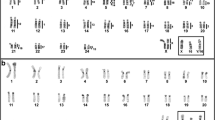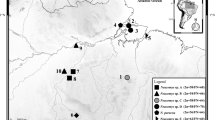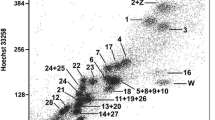Abstract.
We used multidirectional chromosome painting with probes derived by bivariate fluorescence-activated flow sorting of chromosomes from human, black lemur (Eulemur macaco macaco) and tree shrew (Tupaia belangeri, order Scandentia) to better define the karyological relationship of tree shrews and primates. An assumed close relationship between tree shrews and primates also assists in the reconstruction of the ancestral primate karyotype taking the tree shrew as an ”outgroup” species. The results indicate that T. belangeri has a highly derived karyotype. Tandem fusions or fissions of chromosomal segments seem to be the predominant mechanism in the evolution of this tree shrew karyotype. The 22 human autosomal painting probes delineated 40 different segments, which is in the range found in most mammals analyzed by chromosome painting up to now. There were no reciprocal translocations that would distinguish the karyotype of the tree shrew from an assumed primitive primate karyotype. This karyotype would have included the chromosomal forms 1a, 1b, 2a, 2b, 3/21, 4–11, 12a/22a, 12b/22b, 13, 14/15, 16a, 16b, 17, 18, 19a, 19b, 20 and X and Y and had a diploid chromosome number of 2n=50. Of these forms, chromosomes 1a, 1b, 4, 8, 12a/22a, and 12b/22bmay be common derived characters that would link the tree shrew with primates. To define the exact phylogenetic relationships of the tree shrews and the genomic rearrangements that gave rise to the primates and eventually to humans further chromosome painting in Rodentia, Lagomorpha, Dermoptera and Chiroptera is needed, but many of the landmarks of genomic evolution are now known.
Similar content being viewed by others
Author information
Authors and Affiliations
Additional information
Received: 11 February 1999; in revised form: 17 June 1999 / Accepted: 20 July 1999
Rights and permissions
About this article
Cite this article
Müller, S., Stanyon, R., O’Brien, P. et al. Defining the ancestral karyotype of all primates by multidirectional chromosome painting between tree shrews, lemurs and humans. Chromosoma 108, 393–400 (1999). https://doi.org/10.1007/s004120050391
Issue Date:
DOI: https://doi.org/10.1007/s004120050391




